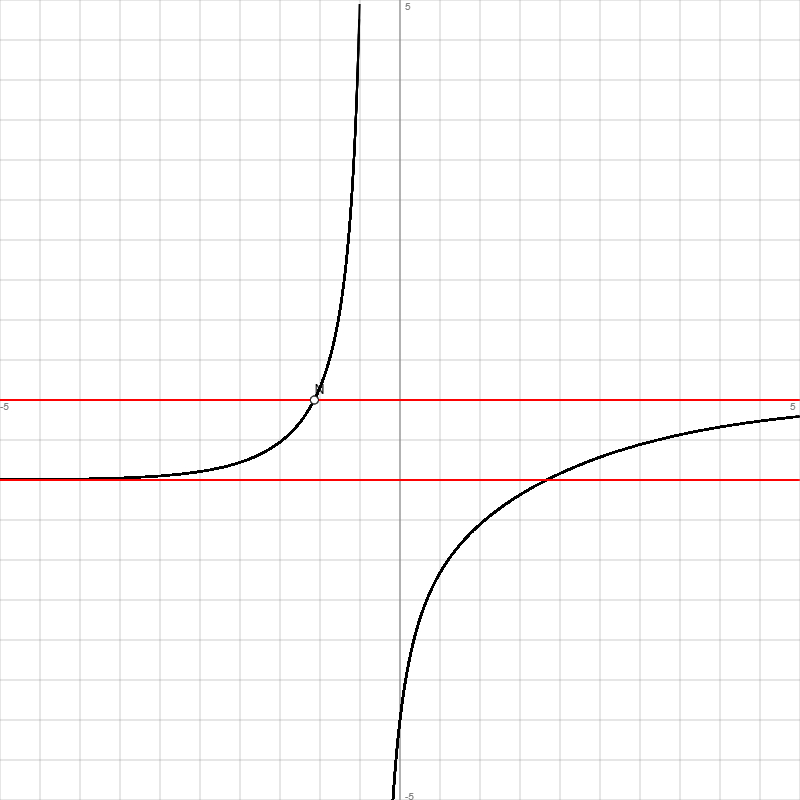 , Df = R, Wf = R, reelle Funktion, x -> -∞: f(x) -> -1 = y als Grenzkurve, x -> +∞: f(x) -> 0 = y als Grenzkurve ->
, Df = R, Wf = R, reelle Funktion, x -> -∞: f(x) -> -1 = y als Grenzkurve, x -> +∞: f(x) -> 0 = y als Grenzkurve ->www.michael-buhlmann.de
Funktion: f(x) =  , Df = R, Wf = R, reelle Funktion, x -> -∞: f(x) -> -1 = y als Grenzkurve, x -> +∞: f(x) -> 0 = y als Grenzkurve ->
, Df = R, Wf = R, reelle Funktion, x -> -∞: f(x) -> -1 = y als Grenzkurve, x -> +∞: f(x) -> 0 = y als Grenzkurve ->
| Wertetabelle: | |||||
| x | f(x) | f'(x) | f''(x) | f'''(x) | Besondere Kurvenpunkte |
| -5 | -0.9973 | 0 | 0.01 | 0.01 | |
| -4.5 | -0.9944 | 0.01 | 0.01 | 0.02 | |
| -4 | -0.9883 | 0.02 | 0.03 | 0.04 | |
| -3.5 | -0.9755 | 0.04 | 0.05 | 0.08 | |
| -3 | -0.9492 | 0.07 | 0.11 | 0.16 | |
| -2.5 | -0.8945 | 0.15 | 0.23 | 0.35 | |
| -2 | -0.7796 | 0.33 | 0.51 | 0.91 | |
| -1.5 | -0.5253 | 0.76 | 1.42 | 3.49 | |
| -1.075 | 0 | 1.95 | 5.29 | 21.4 | Nullstelle N(-1.07|0) |
| -1 | 0.1586 | 2.41 | 7.26 | 33.04 | |
| -0.5 | 5.1538 | 42.15 | 547.08 | 11438.86 | |
| -0.35 | Infinity | Infinity | Infinity | Infinity | Senkrechte Asymptote/Pol x = 2 mit Vorzeichenwechsel: x -> -0.35-: f(x) -> +∞, x -> -0.35+: f(x) -> -∞ |
| 0 | -4 | 8.5 | -47.26 | 398.7 | Schnittpunkt Sy(0|-4) |
| 0.5 | -2.1605 | 1.72 | -3.19 | 11.21 | |
| 1 | -1.5538 | 0.89 | -0.83 | 1.65 | |
| 1.5 | -1.1855 | 0.62 | -0.38 | 0.43 | |
| 2 | -0.919 | 0.46 | -0.25 | 0.17 | |
| 2.5 | -0.7153 | 0.36 | -0.18 | 0.1 | |
| 3 | -0.5573 | 0.28 | -0.14 | 0.07 | |
| 3.5 | -0.4342 | 0.22 | -0.11 | 0.05 | |
| 4 | -0.3382 | 0.17 | -0.08 | 0.04 | |
| 4.5 | -0.2635 | 0.13 | -0.07 | 0.03 | |
| 5 | -0.2052 | 0.1 | -0.05 | 0.03 | |
| Graph: | |||||
 | |||||
Graph(en) der Asymptote(n), Grenzkurve(n).
Abkürzungen: Df = (maximaler) Definitionsbereich, f(x) = Funktion, f'(x) = 1. Ableitung, f''(x) = 2. Ableitung, f'''(x) = 3. Ableitung, H = Hochpunkt, L = Lücke, N = Nullstelle, P = Polstelle, R = reelle Zahlen, S = Sprungstelle, T = Tiefpunkt, W = Wendepunkt, WS = Sattelpunkt, Wf = Wertebereich, {.} = ein-/mehrelementige Menge, [.; .] = abgeschlossenes Intervall, (.; .) = offenes Intervall, [.; .), (.; .] = halboffenes Intervall, ∞ = unendlich.
Bearbeiter: Michael Buhlmann